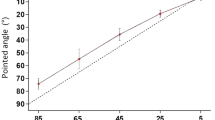Summary
We applied vibration at various rates to the biceps tendon of a passive, restrained arm in normal human subjects and measured its effect on the perception of forearm position and the perception of forearm velocity. The disturbances of limb position perception and limb velocity perception depended on the vibration rate in distinctly different ways. We thereupon applied vibration at various rates to the biceps tendon during the performances of non-visually-guided slow and fast forearm movements. The vibration-rate-dependence of the disturbance of slow movements matched the vibration-ratedependence of the disturbance of limb position perception. The vibration-rate-dependence of the disturbance of fast limb movements matched the vibration-rate-dependence of the disturbance of limb velocity perception. It is concluded that afferent position information is dominant in the control of slow movements, whereas mainly afferent velocity information is used in the control of fast movements.
Similar content being viewed by others
References
Bianconi R, Van der Meulen JP (1963) The response to vibration of the end-organs of mammalian muscle spindles. J Neurophysiol 26: 177–190
Burke D, Hagbarth KE, Löfstedt L, Wallin EG (1976) The responses of human muscle spindle endings to vibration of non-contracting muscles. J Physiol (Lond) 261: 673–693
Capaday C, Cooke JD (1981) The effects of muscle vibration on the attainment of intended final position during voluntary human arm movements. Exp Brain Res 42: 228–230
Capaday C, Cooke JD (1983) Vibration-induced changes in movement-related EMG activity in humans. Exp Brain Res 52: 139–146
Craske B (1977) The perception of impossible limb positions induced by tendon vibration. Science 196: 71–73
Darling WG, Cooke JD (1984) Effects of muscle tendon vibration during acceleratory and deceleratory phases of human limb movements. Soc Neurosci Abstr 10: 336
Goodwin GM, McCloskey DI, Matthews PBC (1972a) Proprioceptive illusions induced by muscle vibration: contribution to perception by muscle spindles? Science 175: 1382–1384
Goodwin GM, McCloskey DI, Matthews PBC (1972b) The contribution of muscle afferents to kinaesthesia shown by vibration induced illusions of movement and by the effects of paralysing joint afferents. Brain 95: 705–748
Lackner JR (1975) Pursuit eye movements elicited by muscle afferent information. Neurosci Lett 1: 25–28
Lehman SL, Houk JC (1984) Adaptation of human wrist movements to inertial loads. Soc Neurosci Abstr 10: 332
McCloskey DI (1973) Differences between the senses of movement and position shown by the effects of loading and vibration of muscles in man. Brain Res 61: 119–131
Prochazka A (1981) Muscle spindle function during normal movement. In: Porter R (ed) Neurophysiology IV. University Park, Baltimore MD (Vol 25, pp 47–90)
Roll JP, Vedel JP (1982) Kinaesthetic role of muscle afferents in man, studied by tendon vibration and microneurography. Exp Brain Res 47: 177–190
Sanes JN, Jennings VA (1984) Centrally programmed patterns of muscle activity in voluntary motor behavior of humans. Exp Brain Res 54: 23–32
Schmidt RA, McGown C (1980) Terminal accuracy of unexpectedly loaded rapid movements: evidence for a mass-spring mechanism in programming. J Motor Behav 12: 149–161
Sittig AC, Denier van der Gon JJ, Gielen CCAM (1985a) Separate control of arm position and velocity demonstrated by vibration of muscle tendon in man. Exp Brain Res 60: 445–453
Sittig AC, Denier van der Gon JJ, Gielen CCAM (1985b) Different control mechanisms for slow and fast human forearm movements. Neurosci Lett 22: S 128
Van Beekum WT (1980) The participation of muscle spindles in human position sense. Thesis. State University Utrecht, The Netherlands
Wadman WJ, Denier van der Gon JJ, Geuze RH, Mol CR (1979) Control of fast goal-directed arm movements. J Human Move Stud 5: 3–17
Author information
Authors and Affiliations
Rights and permissions
About this article
Cite this article
Sittig, A.C., van der Gon Denier, J.J. & Gielen, C.C.A.M. The contribution of afferent information on position and velocity to the control of slow and fast human forearm movements. Exp Brain Res 67, 33–40 (1987). https://doi.org/10.1007/BF00269450
Received:
Accepted:
Issue Date:
DOI: https://doi.org/10.1007/BF00269450




